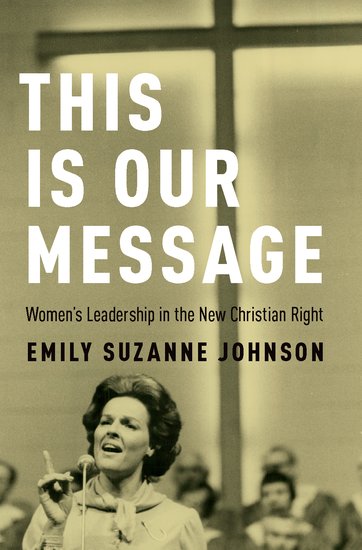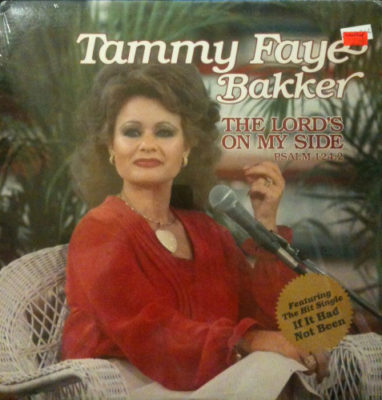Editor's Note
Emily Suzanne Johnson is Assistant Professor of History at Ball State University in Indiana, where she teaches courses on women and gender in modern U.S. history. She took her PhD from Yale University in 2014, and has held fellowships at Washington University, St. Louis and Indiana University-Purdue University Indianapolis (IUPUI).
The interview below is about Dr. Johnson’s first book, This is Our Message: The Politics of Women’s Leadership in the New Christian Right, which was published earlier this year by Oxford University Press. The book is a study of women’s leadership in the New Christian Right, recovering the half of that story which remains poorly understood and little noticed, even as the men who were instrumental in the political ascendancy of that movement have become household names (Jerry Falwell, Pat Robertson, James Dobson, et al.). Johnson closely examines the careers of Marabel Morgan, Anita Bryant, Beverly LaHaye, and Tammy Faye Bakker during the 1970s and 1980s, then looks ahead to the way these women opened spaces for and defined the boundaries of a political space for conservative evangelical women like Sarah Palin and Michele Bachmann in the 2000s and 2010s. She demonstrates not only how large an impact these women have had on national conversations about sexuality and gender, marriage and parenthood, schooling and minority rights, but also how necessary it is to include them in the histories we think we already know well, from second-wave feminism to the culture wars.
[This interview was conducted by Andy Seal. It will run in two parts: one today and one on Wednesday. Check back then for Part II!]

Courtesy of OUP
Andy Seal: One of the key ideas that runs through your book is how important a more flexible reading of the “submission doctrine” was to these women and to their understanding of when they could step forward and claim a public role. Would you explain a bit of the history behind this idea and why it has been so important to the politics of the family among evangelical Christians, and specifically to the women you’ve written about?
Emily Suzanne Johnson: The doctrine of submission is based on Paul’s letters in the biblical New Testament, especially Ephesians 5:22
, which says: “Wives, submit yourselves to your own husbands as you do to the Lord.” There are a wide range of different interpretations of this verse and its contexts, but the “submission doctrine” refers to particular interpretation, which says that there is a divine hierarchy that places God above men and men above women. In this interpretation, a woman is supposed to treat her husband’s will with the same deference that she would pay to God’s own will. The most conservative interpretations pair this with Paul’s instructions against women speaking in church in order to make the argument that all women should be submissive to all men (not just in the marriage relationship).
Of course, even within conservative churches, this doctrine has been subject to interpretation and negotiation. In the 1970s, we start to see these negotiations on a national level. Evangelical subculture went through a period of massive growth after the Second World War, and within that we see the development of a sub-subculture specifically for evangelical women. This revolves around books and lectures on issues related to family and marriage, and the submission doctrine is a core tenet.
Most of the female authors in this subculture define themselves against feminism. They believe in the patriarchal family model and they promote submission doctrine. But even as they promote it, they introduce certain significant tweaks.
Marabel Morgan, whose 1973 Total Woman was the first evangelical marital manual to become a best seller, counseled women that their marriages would be better if they learned to “adapt” to their husbands’ needs and desires. However, Morgan also argued that this gender hierarchy did not exist outside of the marriage relationship – that men and women were essentially equal, but that “someone has to be in charge” when it comes to marriage. Even then, her interpretation of that hierarchy was different from a strict submission model – she often used a corporate metaphor, saying that while the man was “president” of the household, the woman was still an executive “vice president.” She also frequently presented “adaptation” as last resort, for use when a couple couldn’t come to an agreement through discussion or compromise. So even as she promoted a kind of submission doctrine, she also introduced some degree of equity and agency into the philosophy. This was typical of evangelical women’s writing in the 1970s; over the course of a few decades, it noticeably shifted conservative evangelical conversations about gender, marriage, and submission.
AS: I found it really interesting how the language of submission contrasted with a word that was central to the feminist project at this time: liberation. Would you speak to these women’s understanding of what feminism was and how they responded to its goals?

Emily Johnson, Courtesy of Ball State University
ESJ: For most of these women, the feminist movement represented an attack on a way of life that they really wanted. Namely, they wanted to be housewives and mothers, and they felt like feminists were largely dismissive of that choice.
And in large part, they weren’t wrong about that. Betty Friedan’s The Feminine Mystique (1963) – a foundational text for many feminists in this era – revolved around the idea that housewifery was fundamentally stultifying for women. Many feminist campaigns during this era focused on advocating for women’s workforce participation and other non-domestic pursuits. This didn’t leave a lot of room for women who felt proud of and fulfilled by their roles as homemakers. Marabel Morgan spoke for a lot of conservative women when she said that from her perspective, feminists “make the woman at home feel like a dodo.”
There were potential sites of crossover between these groups. For example, most conservative women conceded that equal pay seemed like a good idea for women who chose to work, and women’s groups across the political spectrum became deeply concerned with issues around sex trafficking.
But there were also several divides that were probably unbridgeable. Phyllis Schlafly’s Eagle Forum (founded in 1972) and Beverly LaHaye’s Concerned Women for America (1979) became the political hubs for conservative women’s organizing. Both embraced socially conservative platforms and defined themselves as outright opponents of feminism. They saw the women’s movement as promoting secular humanism, homosexuality, extramarital sex, and government overreach in arenas ranging from education to family law.
AS: Another movement for liberation that corresponds to the timeline of your book is the struggle for LGBT rights. Readers are likely familiar with the outlines of the Anita Bryant story (although your account of the reasons for her downfall were a surprise to me!), but I was not at all aware of the relationship of Tammy Faye Bakker to the gay community. What can we learn from these histories, particularly at a time when the debate about LGBT rights seems to be intensifying within many Christian denominations?

Courtesy of Discogs
Tammy Faye Bakker’s relationship to gay rights is surprising! On one hand, she and her husband hosted Anita Bryant on their televangelical network when Bryant was touring to promote her anti-gay-rights campaign in the late 1970s. But in the mid-1980s, Bakker was also one of the very first people to interview an HIV-positive person on television. [Ed. note: you can view the interview on YouTube here.] And the interview was largely empathetic; Bakker talked about her own experiences with illness and pleaded with her audience to welcome people with AIDS in their own communities. Having an HIV-positive person on the air also allowed him to speak for himself, and to go farther than Bakker would. At one point, he even said: “Jesus loves me just the way I am, I really believe that. Jesus loves the way I love.” This would have been a very different perspective for Bakker’s viewers. The more typical message coming from the religious right at the time was that AIDS was a divine punishment against the nation for its “embrace of immorality,” as Rev. Jerry Falwell put it.
What’s particularly interesting is that, in justifying the interview, Bakker invoked strategies similar to those that Anita Bryant had used to rationalize her leadership in a political crusade. Whereas Bryant talked about protecting children from gay people (and from becoming gay themselves), Bakker talked about protecting gay children from ostracization. Bryant said that her campaign against anti-discrimination legislation was a direct result of her concerns as a mother; Bakker emphasized parents’ sacred duty to love their children “no matter what.” In other words, both women drew on a long history of women framing their political work as an extension of motherhood, which was part of a broader pattern among conservative women in particular at this time.
Two years after the interview, Bakker’s ministry came tumbling down. Her husband was convicted of financial crimes related to fundraising for the ministry. He was also accused of sexual crimes, but never formally charged in connection to those. Tammy Faye Bakker tried to set up a new ministry but was shunned by most of her former friends, and she ended up making a second career as a kind of gay icon. She hosted a daytime talk show with a gay co-host in the 1990s, she became friends with RuPaul, and she wrote a column for a queer youth magazine in the early 2000s.
Interestingly, Bakker always believed that homosexuality was a sin and she never changed her mind about that as far as I know. But throughout her life, she focused on showing people love rather than condemning them. She focused on the idea that all people are sinners and that it was not her place to judge them. By contrast, Anita Bryant believed that she was showing love to gay people by condemning homosexuality and emphasizing that they could change. She would likely say that her approach was more loving since she was trying to save people’s eternal souls.
The thing that strikes me when I look at these stories is the degree of political and theological diversity within the fairly narrow designation of “conservative evangelical.” I think our political discourse encourages us to think about each side of a debate in terms of its loudest and most extreme members. I hope that seeking a more nuanced understanding of political movements might help us to stop shouting past each other and to identify possible entry points for understanding and cooperation, even if there are certain issues (or aspects of issues) that will always produce disagreement.

0